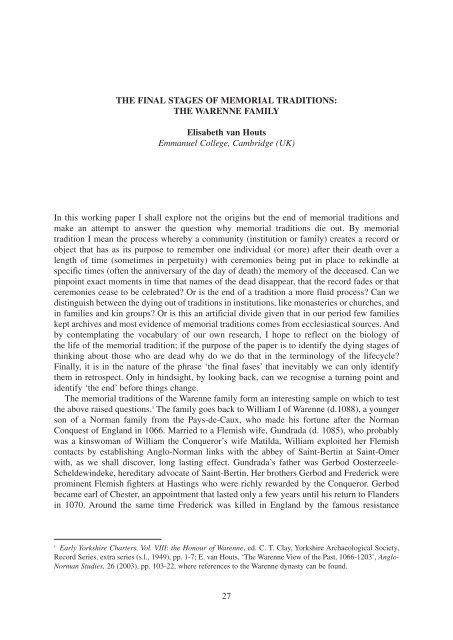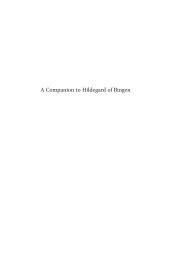Herinnering in geschrift en praktijk in religieuze gemeenschappen
Create successful ePaper yourself
Turn your PDF publications into a flip-book with our unique Google optimized e-Paper software.
THE FINAL STAGES OF MEMORIAL TRADITIONS:<br />
THE WARENNE FAMILY<br />
Elisabeth van Houts<br />
Emmanuel College, Cambridge (UK)<br />
In this work<strong>in</strong>g paper I shall explore not the orig<strong>in</strong>s but the <strong>en</strong>d of memorial traditions and<br />
make an attempt to answer the question why memorial traditions die out. By memorial<br />
tradition I mean the process whereby a community (<strong>in</strong>stitution or family) creates a record or<br />
object that has as its purpose to remember one <strong>in</strong>dividual (or more) after their death over a<br />
l<strong>en</strong>gth of time (sometimes <strong>in</strong> perpetuity) with ceremonies be<strong>in</strong>g put <strong>in</strong> place to rek<strong>in</strong>dle at<br />
specific times (oft<strong>en</strong> the anniversary of the day of death) the memory of the deceased. Can we<br />
p<strong>in</strong>po<strong>in</strong>t exact mom<strong>en</strong>ts <strong>in</strong> time that names of the dead disappear, that the record fades or that<br />
ceremonies cease to be celebrated? Or is the <strong>en</strong>d of a tradition a more fluid process? Can we<br />
dist<strong>in</strong>guish betwe<strong>en</strong> the dy<strong>in</strong>g out of traditions <strong>in</strong> <strong>in</strong>stitutions, like monasteries or churches, and<br />
<strong>in</strong> families and k<strong>in</strong> groups? Or is this an artificial divide giv<strong>en</strong> that <strong>in</strong> our period few families<br />
kept archives and most evid<strong>en</strong>ce of memorial traditions comes from ecclesiastical sources. And<br />
by contemplat<strong>in</strong>g the vocabulary of our own research, I hope to reflect on the biology of<br />
the life of the memorial tradition; if the purpose of the paper is to id<strong>en</strong>tify the dy<strong>in</strong>g stages of<br />
th<strong>in</strong>k<strong>in</strong>g about those who are dead why do we do that <strong>in</strong> the term<strong>in</strong>ology of the lifecycle?<br />
F<strong>in</strong>ally, it is <strong>in</strong> the nature of the phrase ‘the f<strong>in</strong>al fases’ that <strong>in</strong>evitably we can only id<strong>en</strong>tify<br />
them <strong>in</strong> retrospect. Only <strong>in</strong> h<strong>in</strong>dsight, by look<strong>in</strong>g back, can we recognise a turn<strong>in</strong>g po<strong>in</strong>t and<br />
id<strong>en</strong>tify ‘the <strong>en</strong>d’ before th<strong>in</strong>gs change.<br />
The memorial traditions of the War<strong>en</strong>ne family form an <strong>in</strong>terest<strong>in</strong>g sample on which to test<br />
the above raised questions. 1 The family goes back to William I of War<strong>en</strong>ne (d.1088), a younger<br />
son of a Norman family from the Pays-de-Caux, who made his fortune after the Norman<br />
Conquest of England <strong>in</strong> 1066. Married to a Flemish wife, Gundrada (d. 1085), who probably<br />
was a k<strong>in</strong>swoman of William the Conqueror’s wife Matilda, William exploited her Flemish<br />
contacts by establish<strong>in</strong>g Anglo-Norman l<strong>in</strong>ks with the abbey of Sa<strong>in</strong>t-Bert<strong>in</strong> at Sa<strong>in</strong>t-Omer<br />
with, as we shall discover, long last<strong>in</strong>g effect. Gundrada’s father was Gerbod Oosterzeele-<br />
Scheldew<strong>in</strong>deke, hereditary advocate of Sa<strong>in</strong>t-Bert<strong>in</strong>. Her brothers Gerbod and Frederick were<br />
prom<strong>in</strong><strong>en</strong>t Flemish fighters at Hast<strong>in</strong>gs who were richly rewarded by the Conqueror. Gerbod<br />
became earl of Chester, an appo<strong>in</strong>tm<strong>en</strong>t that lasted only a few years until his return to Flanders<br />
<strong>in</strong> 1070. Around the same time Frederick was killed <strong>in</strong> England by the famous resistance<br />
1<br />
Early Yorkshire Charters, Vol. VIII: the Honour of War<strong>en</strong>ne, ed. C. T. Clay, Yorkshire Archaeological Society,<br />
Record Series, extra series (s.l., 1949), pp. 1-7; E. van Houts, ‘The War<strong>en</strong>ne View of the Past, 1066-1203’, Anglo-<br />
Norman Studies, 26 (2003), pp. 103-22, where refer<strong>en</strong>ces to the War<strong>en</strong>ne dynasty can be found.<br />
27
















